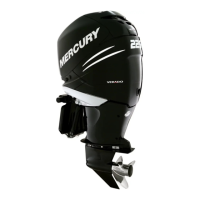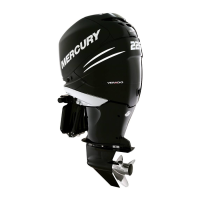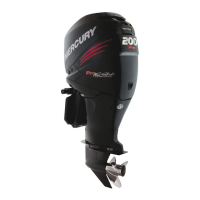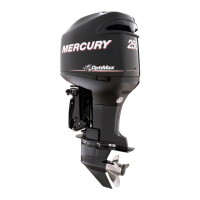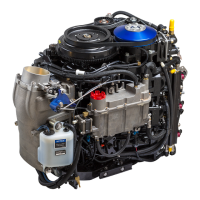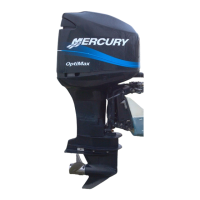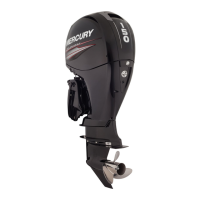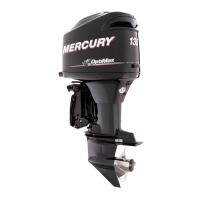Charging and Starting System
90-8M0050731 MAY 2011 Page 2B-27
a - Power stud
b - Start solenoid
c - Starter solenoid
d - 15 amp harness fuse
e - Neutral start switch (tiller handle or remote control)
f - Key switch
g - Battery
Starter Motor Does Not Turn
Test Number Procedure Test Results
1
Set the meter to read voltage, auto range. Measure
the voltage between the starting battery terminals.
Battery voltage should be 12.6 volts or higher. Battery
voltage less than 12.6 volts:
Check the condition of the battery and load test the battery.
Measure the battery voltage between test point 1
(power stud) and a common powerhead ground.
Voltage reading should be the same as the battery. Voltage
reading less than the battery:
• Ensure the battery cables are the correct wire gauge for
the cable length.
• Ensure the battery cable connections are tight on the
battery and on the powerhead.
• Ensure the battery cables are not corroded.
Measure the battery voltage between test point 2
(start solenoid) and a common powerhead ground.
Voltage reading should be the same as test point 1. Voltage
reading less than test point 1:
• Ensure the nuts are torqued to specifications at test
points 2 and 3.
• Ensure the cable connection is not corroded.
Measure the battery voltage between test point 3
(starter solenoid battery power cable) and a common
powerhead ground.
Voltage reading should be the same as test point 2. Voltage
reading less than test point 2:
• Ensure the nuts are torqued to specifications at test
points 3 and 4.
• Ensure the cable connection is not corroded.
Disconnect the low‑pressure and high‑pressure electric fuel pumps from the engine harness. This will prevent the fuel pumps from
activation. Disconnect the crankshaft position sensor from the powerhead wire harness. This will prevent the engine from starting.
NOTE: The disconnection of the harnesses will store failure codes in the PCM. The failure codes must be erased after completing
the troubleshooting procedure.
2
Check for battery voltage at test point 4, between the
starter solenoid yellow/red wire terminal and a
common powerhead ground. Turn the key switch to
the "START" position.
Battery voltage is indicated and the starter solenoid clicks:
Check the battery voltage at test point 9.
• Battery voltage is greater than 9.5 volts ‑ the starter
motor is defective.
• Battery voltage is less than 9.5 volts ‑ the starter
solenoid is defective.
Battery voltage is indicated and the solenoid does not click:
Check the starter ground at test point 10.
• The ground is good ‑ the starter is defective.
• The starter ground has high resistance or is open ‑ clean
the ground cable connection or replace the ground
cable.
No battery voltage indicated: proceed to Test 3
Disconnect the battery voltage supply cable at the starter solenoid test point 3. This will prevent the starter motor from cranking the
powerhead.
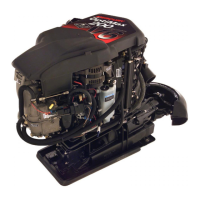
